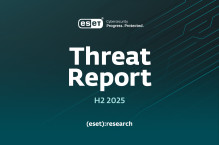Data leaks, as we will explore in an upcoming feature, can emerge in numerous ways. Knowing where your weak spots are as organization is, of course, important, but equally important is ensuring that you actively do everything you can to stay secure and protected.
In this piece we look at five key approaches that will plug any gaping holes in your defenses.
- Boosting security awareness
It is often argued that a good security strategy has to start with people. After all, human error is the most common cause of data breaches, and security solutions can only go so far. Getting security right is as much a cultural challenge as a technical one.
Indicative of how much work is needed, you only need to go back to 2012 to see how unprepared businesses are when it comes to raising awareness. According to an ESET study at the time, a massive 68% of respondents said they had received no training whatsoever.
Things have gotten better, but there is still a lot to do. Today, smart organizations need to ensure that their cybersecurity efforts revolve largely around strong – and thought-provoking – company-wide training programs. This means involving everyone from the CEO to the cleaner, teaching them about phishing, malware and more in interactive sessions that will leave a mark.
It’s important that security awareness is much more than just paper-based assessments or weekly email updates. It needs to be engaging, relevant and above all, interesting. Oh, and it has to be regular – cybercrime is always evolving.
End user security awareness training is a huge benefit, especially when it changes the culture of the company by making it more security minded. Training employees helps eliminate mistakes that could lead to a breach, as well as making them more informed (better able to notice odd behavior by malicious insiders or fraudsters, for example).
- Encrypt data and devices
Encryption is one of the most topical subjects in the world today. While it can certainly trigger many heated debates – it divides governments and tech organizations, for example – most people are of the opinion that it is a positive asset for organizations. As ESET’s Stephen Cobb noted in 2014, “there are a million reasons to encrypt sensitive data”.
Why is it so effective? Well, encryption makes (almost) certain that data is protected at all times, both at rest and in transit. Encrypting your data and device helps reduce the chance of cybercriminals intercepting the data in a man-in-the-middle attack, or of data being accessed by other unauthorized parties.
Organizations should, without hesitation, look to encrypt all sensitive information and devices. A good encryption policy that you can enforce on employee devices is also key. This is essential to helping reduce the likelihood of a possible data leak, which can, in turn, have huge repercussions on businesses.
- Manage your data effectively
Businesses should keep a close eye on what information is being shared with partners, suppliers and customers, and also what their employees are doing on the network. After all, since many companies have a multitude of endpoints, it is vital to monitor the traffic on all networks.
As ESET’s Cameron Camp recently explained: “If you don’t know where your information is, you may not have much luck protecting it legally, or really knowing how that might happen across different overseas jurisdictions if you run into trouble.”
Experts also suggest employing database monitoring tools, which enable businesses to supervise database access and activity. Such software scrutinizes and notifies administrators of any unusual activity, including when an employee downloads, copies, deletes or modifies any sensitive information.
Behavior monitoring is essential, which, along with a data loss prevention solution, should be used to set rules and boundaries. And, given the increasing number of drive-by download attacks on malicious or compromised websites, limiting employee (mis)behavior should not be underestimated.
Essentially, you need to keep a close eye on what’s happening in your environment, and this requires good data logging and skilled staff to look out for anything odd or suspicious.
- Protect the endpoint
In today’s technological age of bring your own device (BYOD), where more employees increasingly use personal mobile devices for work purposes, endpoint management is an essential part of company security - something that many chief information officers consider to be their main focus.
Businesses should still have the ability for central control and monitoring of personal devices connected to corporate networks, even if it means remote wiping the devices if they are lost or stolen. This will require some communication with employees, so a BYOD policy is recommended so that both employees and employers know how devices will be managed and protected.
Endpoint security should include remote wiping, on-disk encryption and endpoint backup – after all, the data must be backed-up somewhere in the event it is lost, stolen or maliciously encrypted.




